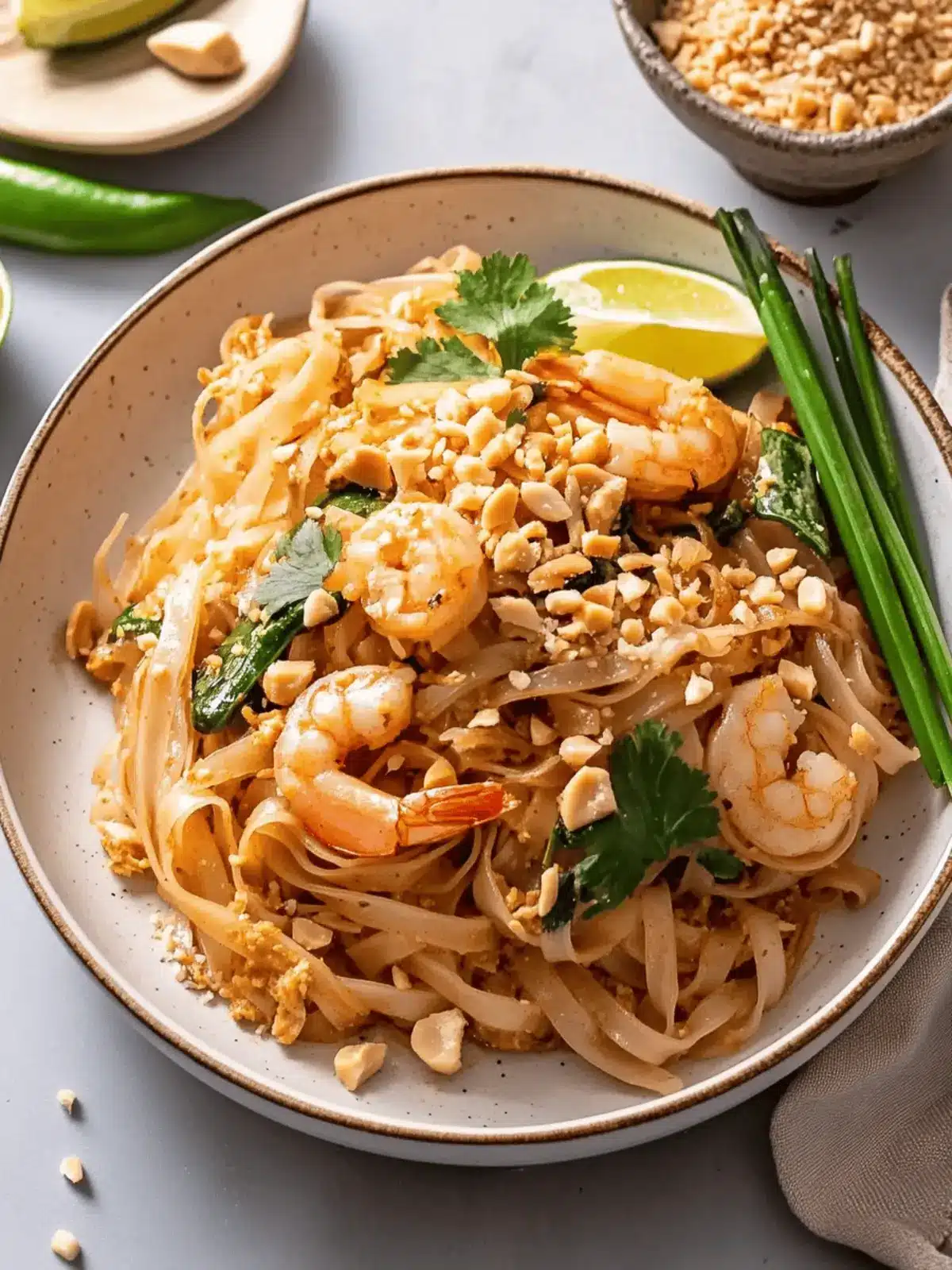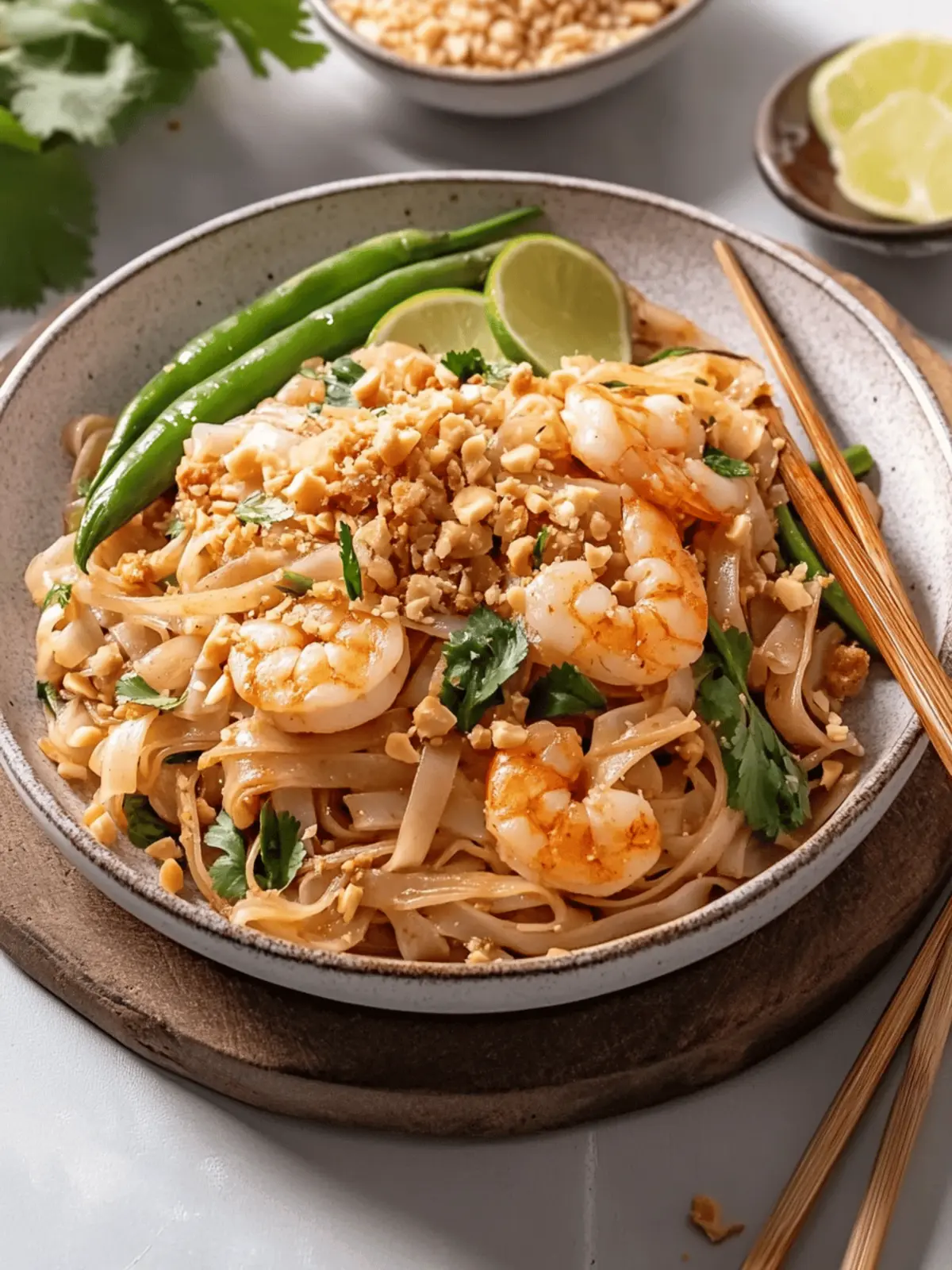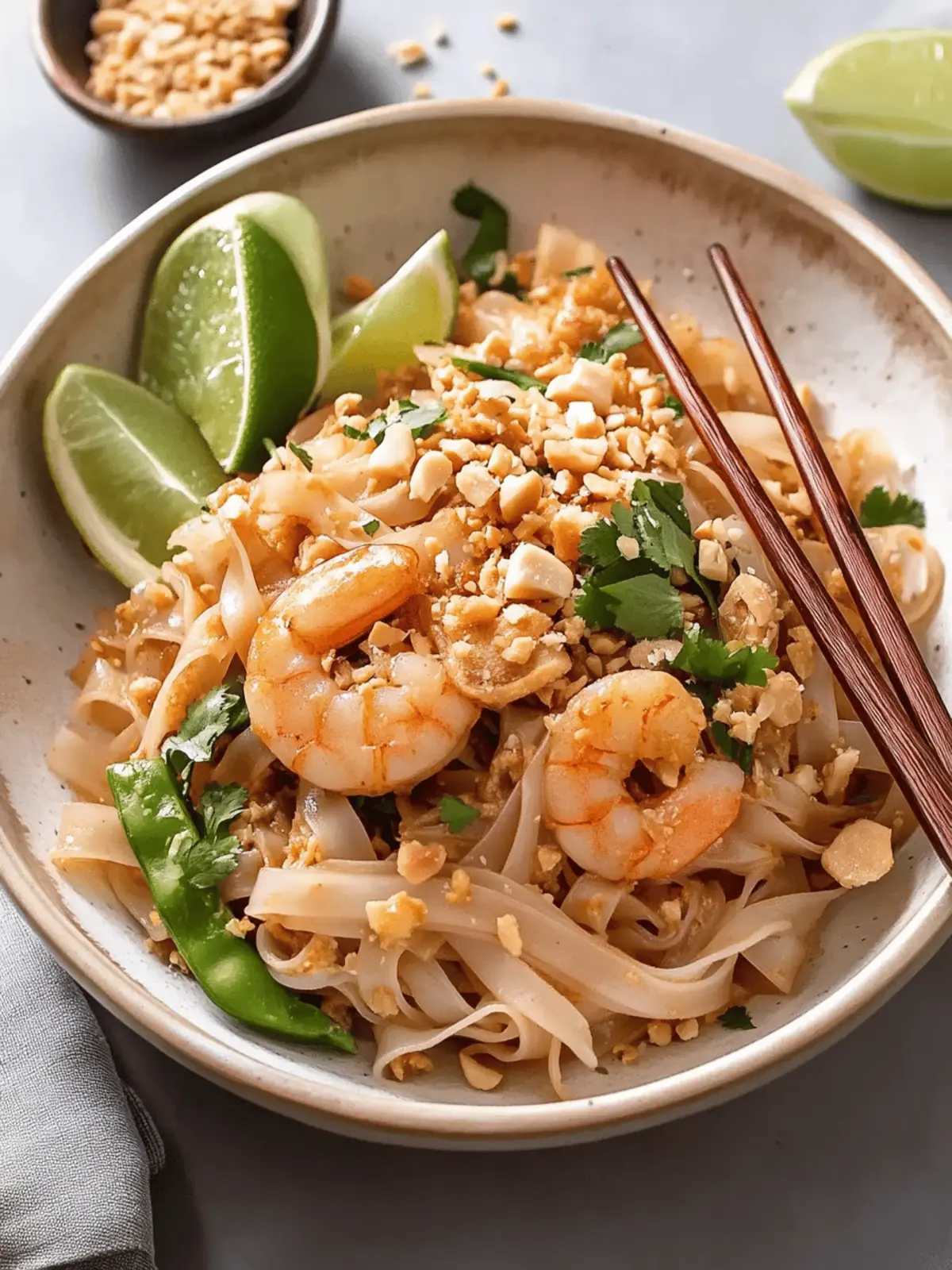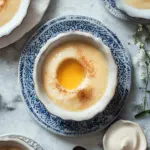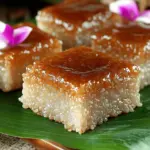There’s something incredibly satisfying about whipping up a meal that not only tantalizes the taste buds but also evokes a sense of comfort. This authentic Easy Pad Thai is my go-to recipe for those busy nights when I crave bold flavors without spending hours in the kitchen. In under 30 minutes, you can master the balance of sweet, salty, sour, and smoky notes that make this beloved Thai dish a favorite.
Imagine the aroma of sautéed garlic mingling with shrimp or crispy tofu, all cloaked in a glossy, homemade sauce that clings to tender rice noodles. The beauty of this recipe lies in its versatility—feel free to customize it with your favorite protein. Whether it’s succulent shrimp, hearty chicken, or plant-based tofu, you can create a dinner that satisfies every craving. With a dreamy array of textures—from crunchy peanuts to fresh bean sprouts—this Pad Thai is sure to impress both family and guests alike. Get ready to experience the joy of home-cooked Thai food, ready faster than you can say “takeout!”
Why is Pad Thai a Must-Try Dish?
Flavor Explosion: Each bite of this Pad Thai hits all the right notes—sweet, salty, and tangy, creating a deliciously unforgettable experience.
Quick Preparation: Ready in under 30 minutes, it’s perfect for those busy weeknights when you crave something special without the long wait.
Customizable Goodness: Tailor it to your taste—swap proteins or add your favorite vegetables for a personal touch.
Crowd-Pleasing Delight: This dish is a guaranteed hit at any gathering, impressing both family and friends with its vibrant colors and flavors.
Texture Variety: Enjoy the combination of chewy noodles, crunchy peanuts, and fresh sprouts that elevate every mouthful!
For more delightful recipes that fit into your busy schedule, check out our section on quick dinner ideas.
Pad Thai Ingredients
For the Sauce
- Tamarind pulp – Adds tanginess; lime juice can work in a pinch, just tweak the sweetness.
- Boiling water – Essential for dissolving the tamarind pulp and making the sauce smooth.
- Brown sugar (or palm sugar) – Provides sweetness; versatile brown sugar is a great substitute.
- Fish sauce – Crucial for umami flavor; soy sauce can be used for a vegetarian variant.
- Oyster sauce – Adds richness; feel free to omit for a vegetarian option.
- Thai soy sauce – Deepens flavor; regular soy sauce is a handy substitute.
For the Noodles & Prep
- Pad Thai noodles – Achieve the dish’s unique texture; alternatives may affect the outcome.
- Garlic – For a fragrant boost; fresh is ideal, but garlic powder will suffice.
- Shallots – Contributes sweetness; onions can easily take their place.
For the Protein
- Shrimp – The main protein; chicken, pork, or tofu are delicious choices for swapping.
- Firm tofu – Provides protein with a lovely texture; substitute with additional shrimp or chicken if you’d like.
- Dried shrimp – Enhances umami; optional if you prefer a lighter touch.
For the Finish
- Eggs – Adds creaminess and richness; you can skip these for a vegan version.
- Bean sprouts – Bring a delightful crunch; shredded cabbage can work as an alternative.
- Garlic chives – Boost flavor and presentation; feel free to use green onions instead.
- Roasted peanuts – For that satisfying crunch; cashews or omitting are nut-free options.
- Lime wedges – Essential for serving; they brighten and balance the dish perfectly.
- Dried chili flakes – Adds desired heat; adjust based on how spicy you like it.
Embrace the joy of cooking Pad Thai, a dish packed with flavor and creativity!
How to Make Pad Thai
-
Prepare the Tamarind: Mix the tamarind pulp with boiling water in a bowl. After a few minutes, strain this mixture to get a smooth puree, discarding any solids.
-
Marinate the Shrimp: Combine your shrimp with Thai soy sauce and fish sauce in a bowl. Allow it to marinate while you prep the other ingredients; this adds depth of flavor.
-
Make the Sauce: In a small bowl, whisk together the tamarind puree, brown sugar, fish sauce, and oyster sauce. This combination will be your delicious Pad Thai sauce!
-
Cook the Noodles: Boil the Pad Thai noodles according to the package instructions until they are al dente. Drain and set them aside until you’re ready to combine them.
-
Sauté the Shrimp: Heat your wok and stir-fry the marinated shrimp until they turn pink and opaque, about 2-3 minutes. Remove and set aside; we’ll add them back in later.
-
Sauté Aromatics: In the same hot wok, add a splash of oil and sauté minced garlic and shallots until fragrant, about 1-2 minutes.
-
Add Tofu and Shrimp: Toss in the firm tofu and dried shrimp, mixing everything well for another 2-3 minutes until golden.
-
Scramble the Eggs: Push the ingredients to one side of the wok, crack in your eggs, and scramble them briefly. Once slightly set, mix everything together.
-
Combine Noodles and Sauce: Add the cooked noodles and the prepared Pad Thai sauce into the wok. Toss gently to ensure everything is coated well and heated through.
-
Finish with Toppings: Incorporate the cooked shrimp, bean sprouts, garlic chives, and roasted peanuts. Toss everything again to combine and serve hot.
Optional: Squeeze fresh lime juice over your Pad Thai for an extra zesty kick.
Exact quantities are listed in the recipe card below.
Pad Thai Variations & Substitutions
Feel free to explore these delightful variations that will personalize your Pad Thai experience and excite your taste buds!
- Dairy-Free: Substitute eggs with additional tofu or chickpea flour to maintain a creamy twist without dairy.
- Spicy Kick: Add fresh chopped chili or sriracha to the sauce for a fiery touch, elevating your dish to new heat levels.
- Protein Swap: Replace shrimp with grilled chicken, pork, or chickpeas for a different flavor profile that suits your cravings.
- Vegetable Boost: Toss in seasonal vegetables like bell peppers, zucchini, or snap peas for added color, texture, and nutrients.
- Nut-Free Option: Omit roasted peanuts and opt for sunflower seeds to keep that crunch without nuts, perfect for allergy concerns.
- Low-Carb Twist: Use zucchini noodles (zoodles) or tofu noodles for a lighter, low-carb alternative that still delivers on taste.
- Sweetener Alternative: For a sugar-free dish, replace brown sugar with stevia or monk fruit sweetener, adjusting based on your preference.
- Umami Depth: Incorporate a splash of miso paste or a drizzle of hoisin sauce for an irresistible richness that enhances all the flavors.
Make Ahead Options
These Easy Pad Thai noodles are perfect for meal prep enthusiasts! You can prepare the sauce (tamarind puree, brown sugar, fish sauce, and oyster sauce) and refrigerate it up to 3 days in advance, ensuring a smooth and flavorful base for your dish. Additionally, marinate the shrimp (or your choice of protein) and store it in the fridge for up to 24 hours, keeping the flavors vibrant. When you’re ready to enjoy your Pad Thai, simply cook the noodles and follow the remaining steps in the recipe, mixing everything in a hot wok. This approach not only saves you time, but also delivers restaurant-quality results with minimal effort!
What to Serve with Pad Thai?
Creating the perfect meal involves more than just the main dish; it’s about the delightful companions that enhance the experience.
-
Cucumber Salad: A refreshing side that cuts through the richness of Pad Thai, this salad offers a cool, crunchy contrast. Toss cucumbers with vinegar, sugar, and a bit of chili for an added kick.
-
Spring Rolls: Crispy, golden spring rolls filled with vegetables or shrimp make an enticing starter, providing a delightful textural variety before diving into your Pad Thai.
-
Thai Iced Tea: This sweet, creamy beverage with hints of spices perfectly balances the savory flavors of Pad Thai, making each bite more enjoyable.
-
Mango Sticky Rice: For dessert, indulge in this classic Thai treat. The sweetness of ripe mango paired with coconut-infused sticky rice is a heavenly way to end your meal.
-
Grilled Corn on the Cob: Charred and slathered with lime and chili, this corn adds a smoky sweetness that harmonizes beautifully with the savory notes of the Pad Thai.
-
Tom Yum Soup: The bold flavors of this spicy and sour soup can awaken the palate. A small bowl of Tom Yum complements the dish without overwhelming your taste buds, adding a zesty touch.
-
Spicy Papaya Salad: This vibrant, spicy salad introduces a refreshing crunch while also enhancing the meal’s complexity with its zesty dressing. The heat provides an exciting contrast to the sweet Pad Thai.
-
Peanut Sauce Dipping Sauce: For a simple addition, serve a small bowl of rich peanut sauce. It can be drizzled over the Pad Thai or served for dipping with fresh veggies.
-
Chili Garlic Sauce: For those who love spice, a side of chili garlic sauce will kick your meal up a notch, giving you the freedom to control the heat!
Elevate your dining experience by thoughtfully pairing these sides with your homemade Pad Thai, making it a meal filled with memorable flavors and delightful textures.
Expert Tips for Perfect Pad Thai
• Noodle Cooking: Soak or blanch the Pad Thai noodles just until al dente; they will continue to cook when mixed with the sauce.
• Hot Wok Essential: Always use a hot wok for quick stir-frying. This prevents overcooking and helps achieve those delicious smoky flavors.
• Protein Balance: When customizing your protein, ensure all options, like chicken or tofu, are cooked evenly for the best Pad Thai experience.
• Sauce Adjustments: Taste and tweak the sauce according to your preference by adjusting sweetness or acidity—never underestimate the power of lime juice!
• Garnish Joy: Don’t skip the toppings like peanuts and fresh sprouts; they add essential texture and brighten up the dish visually and flavor-wise.
• Leftover Love: Enjoy leftovers by reheating in a hot wok to restore that perfect stir-fry texture.
How to Store and Freeze Pad Thai
Fridge: Store your Pad Thai in an airtight container for up to 3 days. Make sure to cool it down to room temperature before sealing to maintain freshness.
Freezer: For longer storage, freeze your Pad Thai in airtight freezer bags or containers. It can last up to 2 months. Note that the texture may change slightly upon thawing.
Reheating: When ready to enjoy leftovers, reheat in a hot wok or skillet for best results, adding a splash of water or sauce to revive the flavors.
Customization Reminder: Remember, your Pad Thai can be made with various proteins, allowing for a delightful twist each time you prepare it!
Pad Thai Recipe FAQs
How do I choose the right tamarind pulp?
When selecting tamarind pulp, look for a rich, dark brown color without any hard lumps. It should be soft and pliable—this indicates freshness. If you’re in a pinch, lime juice can substitute, but remember to adjust the sugar in the sauce to maintain that signature sweetness.
What’s the best way to store leftover Pad Thai?
Absolutely! Store your leftovers in an airtight container after cooling them to room temperature. They can last in the fridge for up to 3 days. If you think you won’t finish them soon, consider freezing for up to 2 months. Just ensure they’re well-contained to prevent freezer burn.
How should I freeze Pad Thai properly?
To freeze Pad Thai, allow it to cool completely, then transfer it into airtight freezer bags, squeezing out excess air. Lay the bags flat to save space. When ready to eat, thaw in the refrigerator overnight and reheat in a hot wok, adding a little water or sauce to bring back moisture and flavor.
What should I do if my noodles turn mushy?
If your noodles get mushy, it might be from overcooking. To prevent this, soak or boil them only until just al dente. Remember, they’ll cook a bit more once mixed with the sauce. If they are already overcooked, try adding a splash of lime juice or a bit of soy sauce to enhance flavor, though texture might be slightly off.
Can I adapt this recipe for dietary restrictions?
Very much so! This Pad Thai is customizable; you can easily swap shrimp for tofu or chicken based on your preferences. For gluten-free options, ensure you use gluten-free soy sauce, and if you’re vegan, simply omit the eggs and oyster sauce. Always feel free to experiment to suit your needs!
Are peanuts necessary in Pad Thai?
While those roasted peanuts do add that delightful crunch, they can be omitted if you’re looking for a nut-free option. Substitute with toasted seeds like pumpkin or sunflower seeds for added texture. Just remember to adjust the toppings to keep that vibrant presentation!
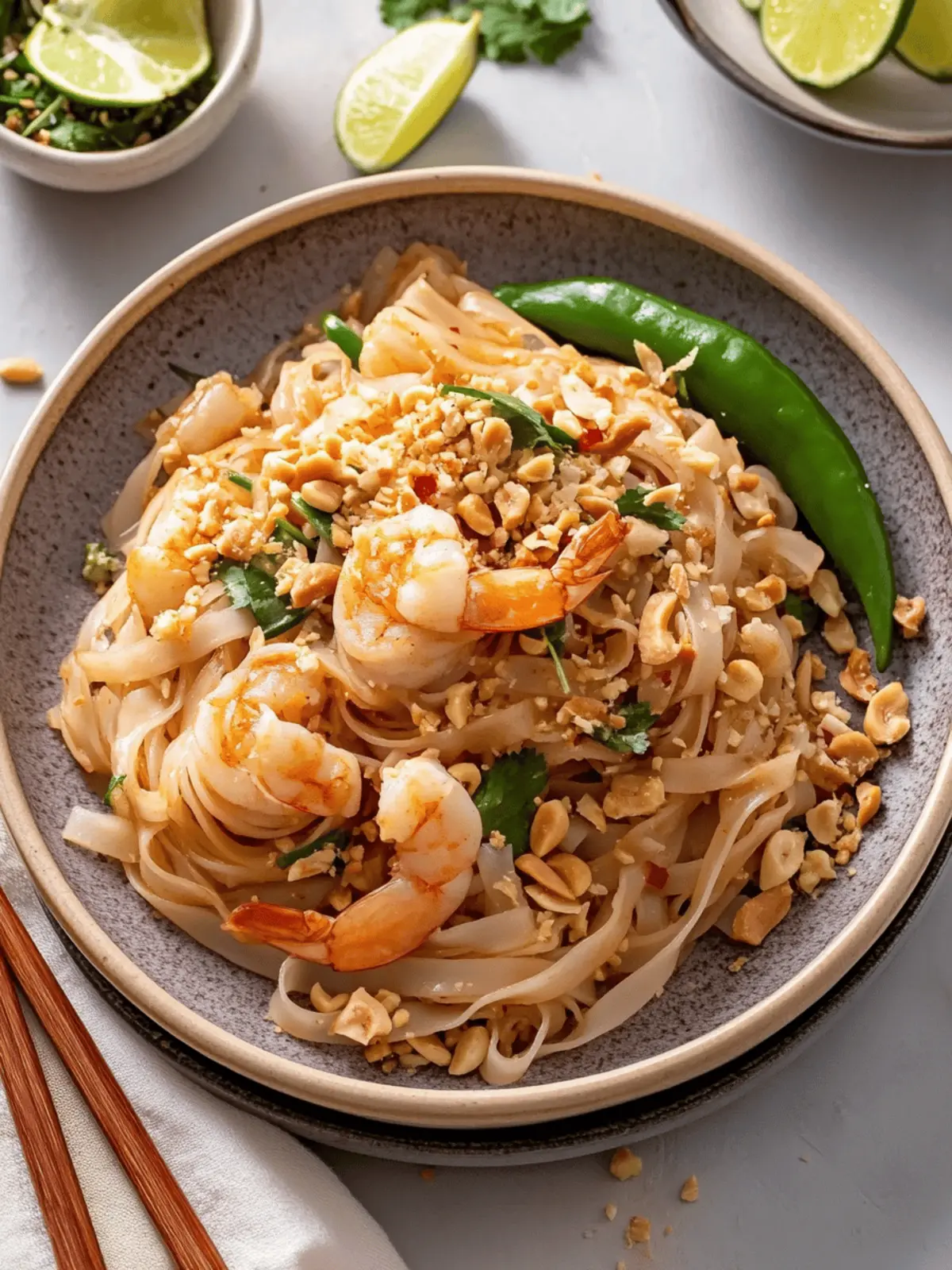
Quick and Authentic Pad Thai You Can Customize Tonight
Ingredients
Equipment
Method
- Mix the tamarind pulp with boiling water in a bowl. After a few minutes, strain this mixture to get a smooth puree, discarding any solids.
- Combine your shrimp with Thai soy sauce and fish sauce in a bowl. Allow it to marinate while you prep the other ingredients.
- In a small bowl, whisk together the tamarind puree, brown sugar, fish sauce, and oyster sauce.
- Boil the Pad Thai noodles according to the package instructions until they are al dente. Drain and set aside.
- Heat your wok and stir-fry the marinated shrimp until they turn pink and opaque, about 2-3 minutes. Remove and set aside.
- In the same hot wok, add a splash of oil and sauté minced garlic and shallots until fragrant, about 1-2 minutes.
- Toss in the firm tofu and dried shrimp, mixing everything well for another 2-3 minutes until golden.
- Push the ingredients to one side of the wok, crack in your eggs, and scramble them briefly. Mix everything together.
- Add the cooked noodles and the prepared Pad Thai sauce. Toss gently to ensure everything is coated.
- Incorporate the cooked shrimp, bean sprouts, garlic chives, and roasted peanuts. Toss everything again to combine and serve hot.

